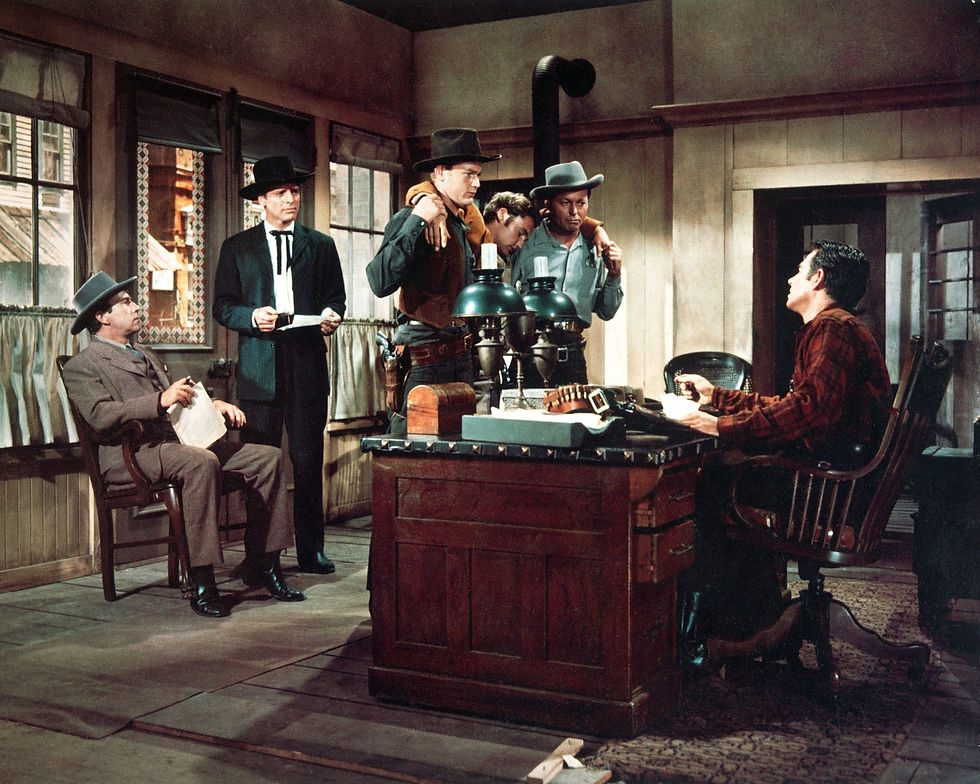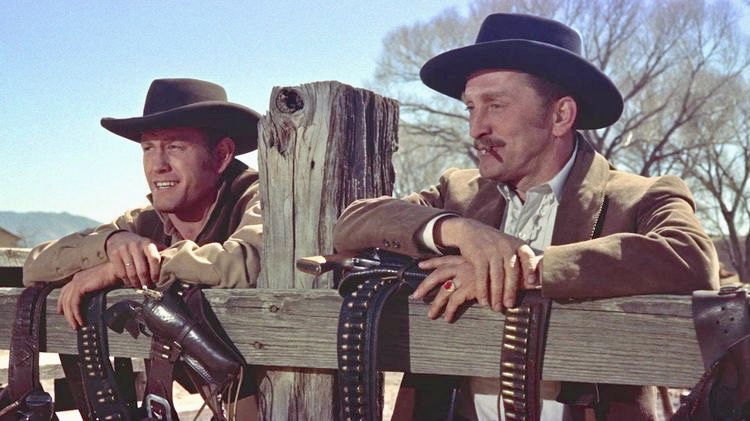Gunfight at the O.K. Corral (1957)
- Soames Inscker

- Jun 27
- 5 min read

Gunfight at the O.K. Corral (1957) stands as one of the definitive cinematic retellings of the legendary shootout that occurred in Tombstone, Arizona, in 1881—a defining moment in the mythology of the American West. Directed by John Sturges and starring Burt Lancaster as lawman Wyatt Earp and Kirk Douglas as the mercurial Doc Holliday, the film exemplifies the scope and drama of the classical Hollywood Western while exploring themes of justice, loyalty, and redemption.
Lavishly produced by Paramount and scored with a sweeping, iconic theme by Dimitri Tiomkin, Gunfight at the O.K. Corral is both a thrilling action film and a psychological character study, bolstered by two powerhouse lead performances and a tightly constructed narrative.
Plot Summary
The film charts the evolving relationship between Wyatt Earp, a principled lawman, and Doc Holliday, a gun-slinging gambler and tuberculosis-stricken dentist with a fatalistic streak. Their unlikely friendship forms the emotional core of the story, which spans from Fort Griffin, Texas, to Dodge City, Kansas, and finally to Tombstone, Arizona—where destiny awaits them in a thirty-second shootout that would become legend.
Wyatt Earp is portrayed as a man of moral integrity who believes in law and order, while Doc Holliday is a complex, tortured antihero—a man ravaged by disease and vice, yet fiercely loyal to his friends. As Earp pursues justice across the West, he finds himself repeatedly entangled with Holliday, and the two eventually stand together against the Clanton gang, culminating in the violent confrontation at the O.K. Corral.

Burt Lancaster as Wyatt Earp
Burt Lancaster gives a restrained, dignified performance as Wyatt Earp, embodying the archetypal Western hero with stoic resolve. Dressed in crisp black attire and exuding quiet authority, Lancaster’s Earp is not a gunslinger by nature, but a lawman driven by a sense of civic duty and personal honor. His portrayal is less flamboyant than others who have played Earp, but it captures the character’s inner moral compass and emotional restraint.
Lancaster’s physical presence and commanding voice bring gravitas to the role. His Earp is calm under pressure and unwavering in his beliefs, but not devoid of emotion—his scenes with Laura Denbow (played by Rhonda Fleming), a lady gambler who becomes his romantic interest, show a gentler, more vulnerable side.
Kirk Douglas as Doc Holliday
In contrast, Kirk Douglas delivers a fiery, magnetic performance as Doc Holliday. Lean, sharp-featured, and full of barely suppressed rage, Douglas’s Holliday is a man haunted by illness and past sins. With a Southern drawl and a cynical wit, Douglas creates a portrait of a man who is both self-destructive and strangely noble.
Douglas’s Holliday is unpredictable—dangerous one moment, melancholy the next. Yet despite his cynicism, he displays immense loyalty to Wyatt Earp, a bond that becomes the emotional backbone of the film. His relationship with the saloon girl Kate Fisher (Jo Van Fleet) adds another layer of complexity, showing Holliday as a man capable of love but incapable of peace.
Douglas steals nearly every scene he’s in, and his performance remains one of the most memorable interpretations of Doc Holliday ever put to screen—an enduring rival to later portrayals by Val Kilmer (Tombstone) and Dennis Quaid (Wyatt Earp).
Supporting Cast and Characters
Jo Van Fleet delivers a gritty, emotionally raw performance as Kate Fisher, Doc’s long-suffering lover. She’s passionate, jealous, and tragic—a woman unable to save the man she loves.
Rhonda Fleming adds glamour and a romantic subplot as Laura Denbow, though her role is more symbolic than substantive. She represents a possible future for Wyatt beyond the lawless frontier.
John Ireland, Lyle Bettger, Lee Van Cleef, and Dennis Hopper all appear as Clanton gang members or minor outlaws, rounding out a strong supporting cast with dangerous energy.
The film balances action with character development, allowing time for the audience to invest in the fates of its leads, even as the climactic confrontation looms.
Direction and Cinematic Style

John Sturges’s direction is methodical, deliberate, and effective. He understands the value of pacing and buildup, allowing tension to simmer across the film’s 122-minute runtime. While some modern audiences may find the early sections slower, the gradual development of the Earp-Holliday relationship makes the final act all the more satisfying.
Sturges was a master of ensemble storytelling, later proven in The Magnificent Seven and The Great Escape, and here he begins to shape his signature style: clean, classical compositions; strong use of location; and climactic action sequences that pay off the slow burn.
The film was shot in Technicolor VistaVision, and the widescreen format captures both the beauty of the Western landscapes and the intimacy of interior scenes. Cinematographer Charles Lang’s work gives the film a rich visual tone, oscillating between bright sunlit exteriors and moody, smoky interiors of saloons and jailhouses.
Music and Atmosphere
Dimitri Tiomkin’s score is one of the film’s defining elements, particularly the main theme, sung by Frankie Laine, which plays like a Western ballad chronicling the tale’s events. Though the use of vocal narration in the theme may strike some as heavy-handed, it gives the film a mythic, almost folk-legend quality. The music underscores the grandeur and inevitability of the story.
Historical Accuracy vs. Mythmaking
Like most Hollywood Westerns of the era, Gunfight at the O.K. Corral takes liberties with historical fact. The real events in Tombstone were far more ambiguous than the film suggests, and the real Doc Holliday and Wyatt Earp had a relationship marked by tension as well as loyalty. The film’s version of the gunfight, though extended and cinematic, diverges significantly from the real-life thirty-second shootout.
Yet this is not a documentary. It is mythmaking—part of the ongoing legend of the American frontier. The film acknowledges this by framing the story in epic terms, turning Wyatt Earp and Doc Holliday into near-mythic figures battling chaos and corruption in a lawless land.
Reception and Legacy
Gunfight at the O.K. Corral was a box office success upon its release and remains one of the classic Hollywood Westerns. It helped define the tone and structure of many Westerns to follow, particularly in its focus on flawed heroes and complex moral choices. The film was nominated for two Academy Awards: Best Film Editing and Best Sound.
More significantly, the film cemented the Earp-Holliday story in cinematic tradition, paving the way for future adaptations such as Hour of the Gun (1967, also directed by Sturges), Tombstone (1993), and Wyatt Earp (1994).
Conclusion
Gunfight at the O.K. Corral remains a landmark Western—rich in character, steeped in moral tension, and elevated by the magnetic pairing of Burt Lancaster and Kirk Douglas. It dramatizes the tension between law and chaos, civilization and savagery, friendship and fatalism. While its historical liberties are apparent, its emotional truths and cinematic artistry endure.
With a legendary cast, iconic score, and masterful direction, the film encapsulates the mythic grandeur of the Old West. It’s not just a story of a shootout—it’s a story about the costs of justice, the power of loyalty, and the tragedy of men who can’t escape their fate. As far as Westerns go, Gunfight at the O.K. Corral remains locked and loaded among the genre’s very best.





